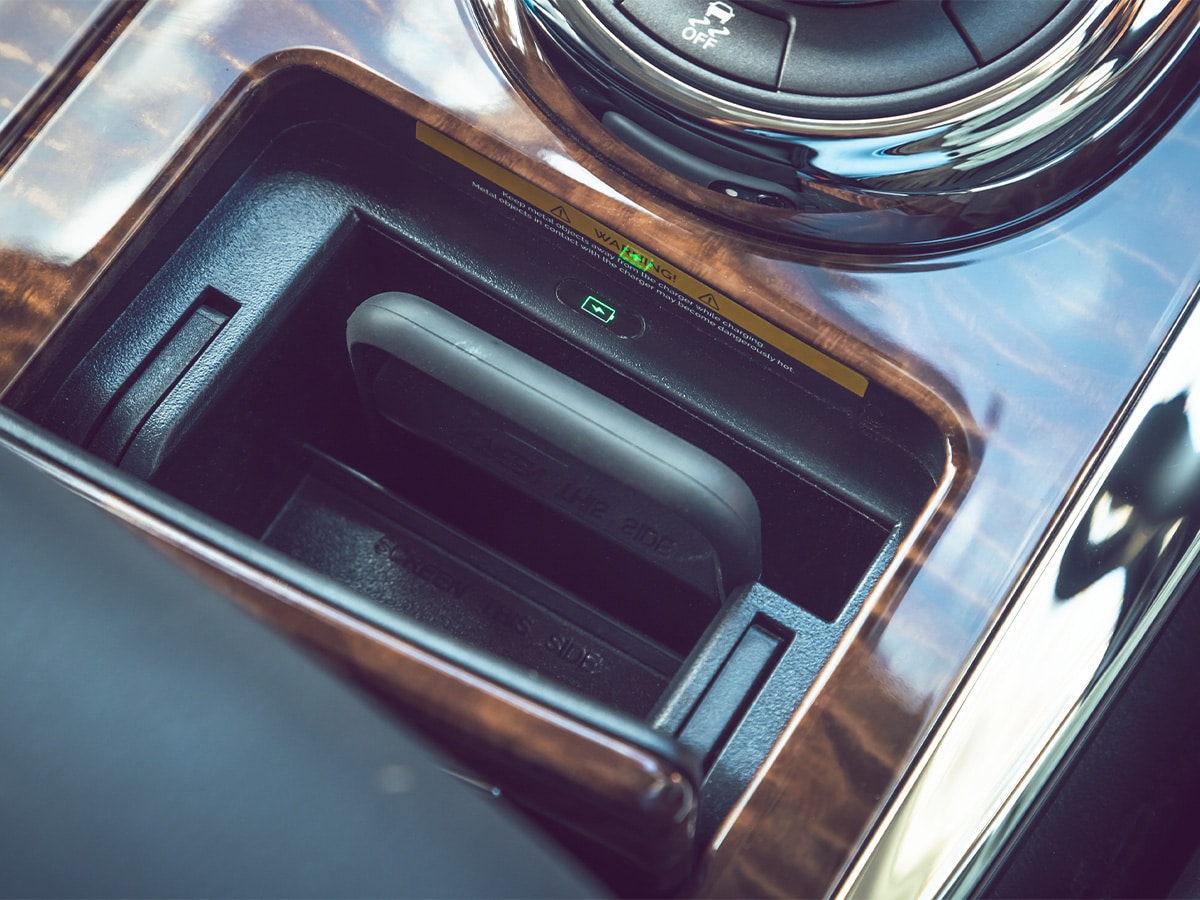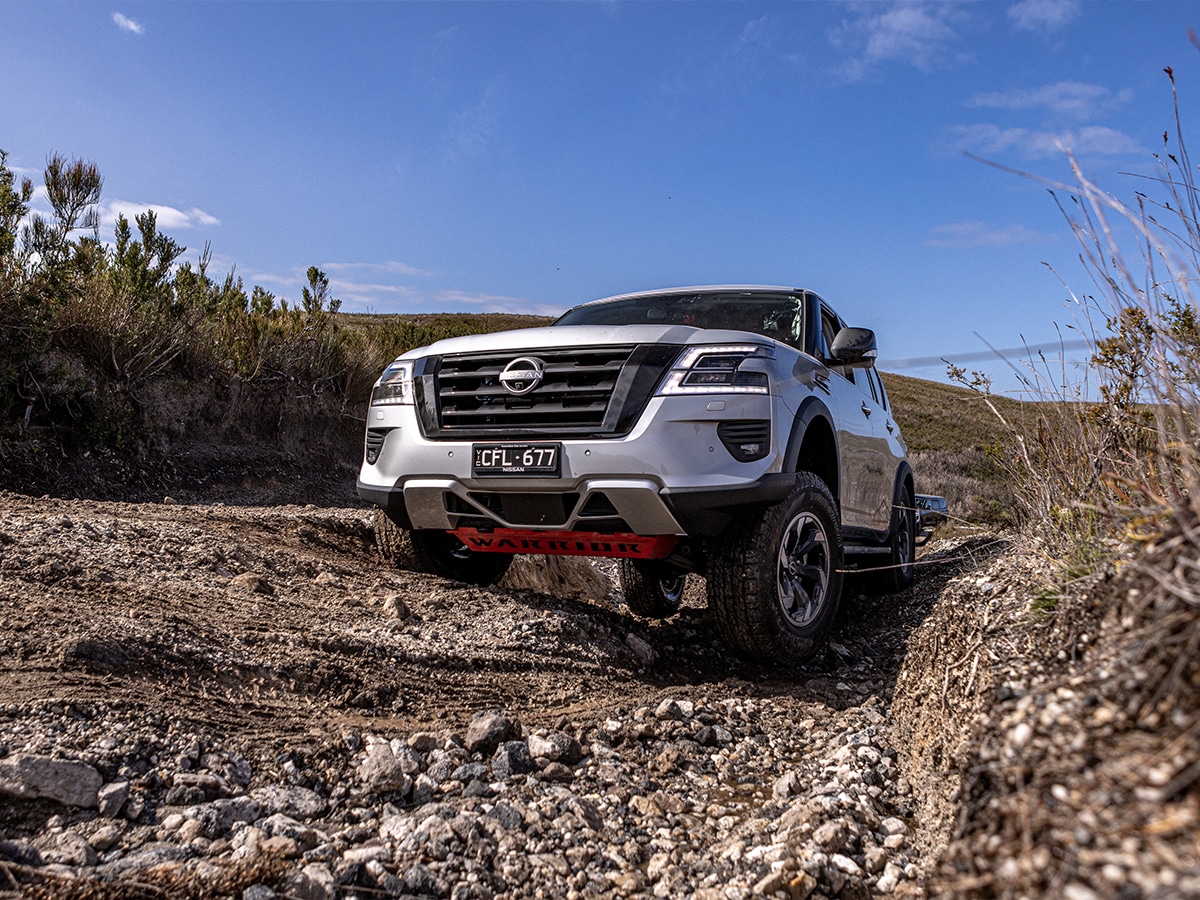
Published:
Readtime: 10 min
Every product is carefully selected by our editors and experts. If you buy from a link, we may earn a commission. Learn more. For more information on how we test products, click here.
The Nissan Patrol Warrior (from AUD$101,160 plus on-road costs) proves that new is not always “better.” Based on a Y62 platform that has been around since 2010, Australian outfit Premcar has taken the mid-range Patrol Ti and handed it the most comprehensive Warrior re-engineering package to date. The results speak for themselves and the Warrior provides an enjoyable throwback experience that you simply won’t find in the boring, toned-down, and quite frankly, characterless 4WDs on the market today.
With the infamous 298kW 5.6-litre VK56VD V8 petrol engine at its core, the Nissan Patrol Warrior delivers character in spades. However, after spending a week with the Patrol Warrior, I’m pleased to say that there’s more to this car than a shouty V8 with side pipes.
There’s real substance here with key upgrades that elevate the vehicle’s capabilities on and off the road, including a unique wheel, tyre and suspension package (50mm lift), re-engineered Hydraulic Body Motion Control (HBMC) system, 120kg GVM upgrade, bi-modal exhaust, and exterior treatments that toughen it up with an aggressive stance. There’s even a new 10.1-inch high-definition central touchscreen with wireless Apple CarPlay and wireless Android Auto to finally add some tech inside the cabin.
RELATED: New Nissan Patrol Revealed, Due in Australia Late 2026.
How Much is the Nissan Patrol Warrior?
The Nissan Patrol Warrior is priced from AUD$101,160 plus on-road costs, which makes it the most expensive Patrol money can buy in Australia.
Here’s a full list of pricing for the Patrol line-up:
- Nissan Patrol Ti – from AUD$84,900 plus on-road costs
- Nissan Patrol Ti-L – from $97,600 plus on-road costs
- Nissan Patrol Warrior by Premcar – from $101,160 plus on-road costs
It’s worth noting here that the Nissan Patrol Warrior is based on the base-model Nissan Patrol Ti, which means that it misses out on the features found on the Nissan Patrol Ti-L, including:
- 7 seat capacity
- Driver’s seat memory with two settings, including side mirrors and steering column position
- First-row centre console cool box
- 13 premium BOSE® speakers
- Two second-row seat 8-inch entertainment screens with headphones and remote control
- Intelligent Rear View Mirror (I-RVM)
- Puddle illumination light
- Power operated tailgate
- Roof rails
- Sunroof (electric one-touch power tilt & slide) with Privacy Glass
- Heated and cooled front seats
- Tilt and telescopic electronically adjustable steering column
- Premium bumper
It’s a bit unfortunate that you don’t get things like heated and cooled front seats, premium BOSE® speakers, and a power-operated tailgate on a vehicle that costs more than one hundred thousand dollars.

What’s the Interior Like in the Nissan Patrol Warrior?
- Boot capacity with all three rows in use: 467 litres
- Boot capacity with the third row folded down: 1413 litres
- Boot capacity with both the second and third rows folded: 2623 litres
Compared to other new 4WDs in its class such as the Toyota Prado, Toyota LandCruiser, Jeep Grand Cherokee L, Land Rover Defender, and even other Nissan products such as the Xtrail and Pathfinder, the interior of the Nissan Patrol Warrior is quite outdated. Still, the fit and finish is good, there’s plenty of leather, and the Warrior adds sporty Alcantara on key cabin equipment like door trims and the instrument panel.
There’s a passenger dash inlay with the stylised “Warrior” logo, and the centre console, floor console and storage lids receive a gloss black painted finish with a deep gloss topcoat for durability.
Lovers of physical buttons will be happy in the Patrol Warrior, and we haven’t seen this many buttons inside a new vehicle in a very long time. They control features such as climate controls and navigation shortcuts, but also the rear diff-lock, downhill assist, traction control, and drive modes: sand, snow, on-road, and rock.




The biggest change inside the cabin for the 2024 Nissan Patrol is the new 10.1-inch high-definition central touchscreen with wireless Apple CarPlay and wireless Android Auto.
The upgrade to the infotainment screen arrives alongside a host of other handy features including two USB ports (1x USB-A and 1x USB-C) and a 15w wireless charging pocket to keep your phone’s battery charged while screen mirroring. There’s also DAB+ Radio, six speakers (optional Infinity Premium Audio on Ti-L models only), an intelligent rearview mirror, and a first-row centre console cool box like the Toyota LandCruiser 300.
Keeping the offroad fans front and centre, the brand has added iGO Street Navigation and a 1-month free subscription to Hema 4×4 Navigation as part of the deal. We used this system on a trip to the Simpson Desert and it was an absolute game-changer, adding plenty of peace of mind to our trip when mobile phone reception dropped out and in-depth information became unavailable on Google Maps offline.
Ultimately, you’re not buying a Nissan Patrol Warrior for a cutting-edge interior. However, it does satisfy pretty much all of our needs during our week of use. Some will find the pragmatic nature as a benefit, not a drawback. We’re one of those people, and the new infotainment screen is a worthy addition to all Patrols.

What Powers the Nissan Patrol Warrior?
- Engine: 5.6-litre naturally aspirated V8
- Power: 298kW @ 5800rpm
- Torque: 560Nm @ 4000rpm
- Transmission: 7-speed automatic with full-time 4WD, low-range gearing, and rear differential lock
- 0-100 km/h Acceleration: ~7.3 seconds (estimated)
- Towing Capacity:
- Braked: 3500kg
- Unbraked: 750kg
- Tow ball download: 350kg
- Fuel Economy: 14.4L/100km (combined cycle)
- Fuel Type: Minimum 95 RON premium unleaded
- Fuel Tank Capacity: 140 litres
The Nissan Patrol Warrior is powered by a 5.6-litre naturally aspirated V8 that produces 298kW @ 5800rpm and 560Nm @ 4000rpm. With a twin-turbo V6 Patrol on the way in 2026, Nissan is saving the best till last with the Warrior model and it’s highlighted by an exciting bi-model exhaust system that takes notes from the Mercedes-AMG G 63 SUV.

Premcar has added this new exhaust system to benefit the development goal of increasing the vehicle’s capability without compromising on Noise, Vibration and Harshness (NVH). They say that while owners love the sound of an aftermarket exhaust system, to unleash the glory of the 5.6-litre V8, the drone and vibration of these systems at highway speeds often ruin the ambience of the interior and quickly become tiresome on longer journeys.
To avoid an overly droney, loud, and obnoxious sound when cruising around town, the muffler and pipe assembly is locally manufactured out of 409 stainless steel. The twin-tip side-exit exhaust then exits just ahead of the driver’s side rear wheel, which is directly in earshot when you put your foot down.
It’s electronically operated, and opens when engine RPMs climb above 2,500-3,000rpm, but stays open permanently when the seven-speed automatic is flicked over into manual mode.

How Does the Nissan Patrol Warrior Drive?
The Nissan Patrol Warrior drives exactly how you would imagine a 5,269mm long, 2,884kg, 8-seat SUV on large offroad tyres would drive. It’s boaty, barge-like, and slow to react to any form of driver input. This doesn’t make it “bad” per se, but if you’ve driven any modern SUVs, including the LandCruiser 300 Series, then the difference is rather stark.
Premcar has re-developed the Hydraulic Body Motion Control (HBMC system) but it’s still a rudimentary system and it doesn’t bring the Warrior up to speeds with the tech found in most modern SUVs.
On paper, it sounds like it should function similarly to the systems found in cars like the new Range Rover Sport SV. However, I can’t say I noticed it working at all during my week with the car. It’s comfortable around town, it’s comfortable offroad on fire trails, and it’s a beast on rock steps and in the mud, but I wouldn’t have even realised this system existed if I hadn’t double-checked the brochure.



The outfitter claims the developed and tested HBMC valve componentry changes have improved the existing capability of the Patrol, including improvements in both on- and off-road handling, steering response, feel and confidence. However, it would be a long shot to call the Warrior the benchmark of ride and handling.
Points are given to the independent rear suspension architecture that provides increased comfort over the solid-axle solutions found on so many 4WDs. However, points are taken away for a steering system that is overly assisted, unbelievably lightweight, and slow. You have a difficult time knowing what the front wheels are doing most of the time, but at the same time, I don’t care about this because I’m not looking for a sportscar-like driving experience from the Patrol Warrior.
In terms of pure offroad ability, various changes to componentry have increased the Warrior’s capabilities, including a suspension lift (+29mm) and 295/70 R18 Yokohama Geolandar GO15 tyres which add a further (+21mm) for a total lift of 50mm. There’s also a wider track width of +40mm (1,695mm to 1,735mm) compared to the Patrol Ti, which improves vehicle handling and stability across offroad terrains.
Last but not least, the front spring rate has reduced from 125N/mm on the standard Patrol to 113N/mm for the Patrol Warrior, while at the rear the springs have been changed to a progressive triple-rate design that allows the suspension to progressively soften to around 40N/mm at full extension.
Simply put, it’s more comfortable to drive offroad, which is where most owners will be taking their Warrior. Is it better offroad than a standard 300 Series LandCruiser? Yes.

Should You Buy the Nissan Patrol Warrior?
You shouldn’t hesitate to pick up a Nissan Patrol Warrior if you’re tempted by the 5.6-litre naturally aspirated V8 and you have deep enough pockets to spend a great deal of your time at the fuel bowser.
Yes, the Toyota LandCruiser 300 Series GR Sport ($145,876 before on-roads) is the more sensible choice, despite costing substantially more, but the Warrior has a throwback charm to it that you won’t find in other 4WDs moving forward. Character is hard to find in modern vehicles, but the Warrior has an attitude.
By adding the new infotainment touchscreen with Apple CarPlay and Android Auto, Nissan has brought the Patrol as far forward into the modern era as possible before the new twin-turbo petrol V6 arrives in Australia in 2026. Still, the interior is outdated and there’s no getting around it.
Ultimately, it’s a balancing act, but for many, the pros of the Nissan Patrol Warrior far outweigh any cons. It’s still one of the best choices if you’re looking for a daily driver that can transform itself into a fun weekender or family hauler for a lap of Australia at a moment’s notice. Long live the V8!

You’ll also like:


































Comments
We love hearing from you. or to leave a comment.